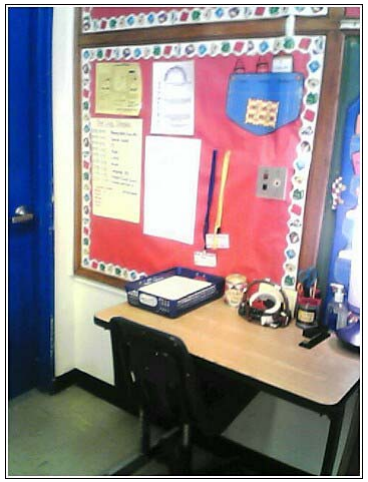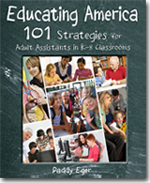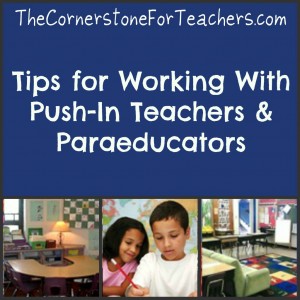This page will help you discover strategies for paras and push-in teachers to work effectively with general education teachers. You’ll find tips for both classroom teachers and paras.

Setting Up Space for Paraeducators
When I was a general education teacher, there were several years when I had either a one-on-one student aide (for very high needs students) or a teaching assistant (when I taught Pre-K). Personally, I feel that if the teacher has his or her own desk and special area for work, paraeducators deserve to have the same. The paraeducator’s space might not be as large, since s/he is not in the classroom all day and/or doesn’t have as many papers and materials to keep track of as the general education teacher. And depending on the size of your room, this may not be an area used exclusively by the paraeducator. But it should be a place where they can feel comfortable and have access to the materials they need.

The photo to the left was my “para/parent table” one school year. I had a very tiny, windowless classroom that year so this was basically the doorway area. I kept a list of things I needed done on top of the basket you see on the left. Anytime I thought of a task that a parent volunteer or para could do, I jotted it down there, and put asterisks next to the most important tasks. This way paras could choose things that they enjoyed doing and were good at, and could get started immediately without having to interrupt instruction to find out what I needed. The para crossed off each item as it was completed and put the finished product(s) on my desk so I knew they were done.
Another year, my para worked in the area that was used for our social studies center. It was a table with four chairs and a book shelf. She covered two of the shelves with a tension curtain road and hung a curtain over it to hide her materials, and the students’ materials were on the other two shelves. She sat at that table when she worked one-on-one with the ESE student she was assigned to. Her personal belongings were kept in an cabinet (along with mine) behind my desk.
Training Paraeducators to Work with Students
If your para has clearance to work one-on-one or in small groups with students, that’s even even better! If the para is only in the room for part of the day, I often have them work in the hallway or an empty classroom with students. This prevents the students I’m working with from being distracted andthe noise level from rising too high, and makes it easier for the para to get his or her students focused, as well. In situations in which I couldn’t arrange this or it wasn’t necessary, I would try to set up our daily schedule so that I wasn’t instructing while the para was in the room. When the whole class is doing the same thing at the same time, having another adult in the room pulling kids away from that situation sometimes feels disruptive. But when students are working in centers or small groups or projects, the movement and “buzz” fit right in.
Sometimes I would have adult assistants work with below-grade-level students. This might involve flashcard drills, teaching remedial lessons, going over previously completed assignments, etc. Often the best (and most enjoyable) use of the para’s time was simply reading with students. Your para might also be able to run a reading group or math group.
I like to keep the role of the paraeducator as flexible as possible, and base the structure and tasks on the needs and strengths of both the adult and the child(ren) he or she is working with. I’ve found that setting up a month-by-month plan often works best: discuss the goals for the upcoming weeks, then meet briefly to evaluate how things are going and the direction in which to go next.
Working With Push-In Teachers
With so many schools using Response to Intervention (RTI), there are many more special education teachers pushing in to the general education classroom, as opposed to pulling students out to a separate class. This can be fantastic for students but very challenging for teachers, especially when both are used to having their own classrooms.
If you are general education teacher, the most important piece of advice I can offer is this: make sure the students know that you and the psuh-in teachers are equals in the classroom, and always treat the push-in teacher as an equal authority. Remember, it’s not just your classroom, it belongs to your students, too! When you think about it that way, it’s much easier to give up control and allow another adult to have some say as to how
If you are the push-in teacher, I’d advise you to follow the classroom teacher’s lead whenever possible. Since you’re entering a space where someone else has already set up the physical arrangements, routines, behavioral expectations, etc., you’ll save yourself a lot of frustration if you follow the classroom teacher’s lead.
Obviously you can tell that the underlying theme of my advice for both general ed teachers and push-in teachers is mutual respect. There is no single right way to teach fewer wrong ways than most of us tend to think. Be flexible, be kind, be patient.
Advice From an Expert on Paras and Push-In Teachers

Paddy Eger’s book Educating America: 101 Strategies for Adult Assistants in K-8 Classrooms isthe best resource I’ve seen on this topic. It’s based on the principle that one teacher cannot (and should not) meet the needs of an entire classroom full of students alone. Community and parent support are needed now more than ever, and school workers as well as corporate and community groups need to know how they can be most useful in the classroom.
One of the most remarkable things about this book is that its advice applies equally well to teachers, parents, volunteers, para-professionals, and other classroom assistants (the first part of the book contains more general strategies, with separate chapters written “mostly” for each type of classroom worker.) Educating America tackles tricky topics from setting expectations to monitoring student progress. The advice goes far beyond common sense stuff and provides genuinely useful tips that you can tell are effective in real classrooms.
Paddy provides realistic examples of how classroom assistants can be truly valuable in helping meet the needs of students, explaining in plain English how they can use questioning strategies with kids and help them develop thinking skills. There is an entire chapter on how assistants should handle misbehavior, and the appendix includes helpful checklists and planning worksheets.
I think this book meets a big need right now in providing practical resources and advice on incorporating adult assistants in the classroom. Paddy’s website also has full-size worksheets that can be downloaded, with new resources added weekly. If you are looking for tips from an educator who’s been there, I highly recommend Paddy’s book and website!

Angela Watson
Founder and Writer
Discussion
Leave a Reply
OR

Join our
community
of educators
If you are a teacher who is interested in contributing to the Truth for Teachers website, please click here for more information.
















I am a 12 year 5th grade teacher. I teach all subjects. This year I will have a push-in ESE teacher for math and reading. I have the math figured out. I do centers in math and reading and the push-in will work well working with the small group of the ESE students. My problem is how to best utilize the push-in while I am doing whole group instructions. Our district got rid of read 180 and this is the first year of push-in for reading so there is little guidance available for me. Any thoughts would be appreciated.